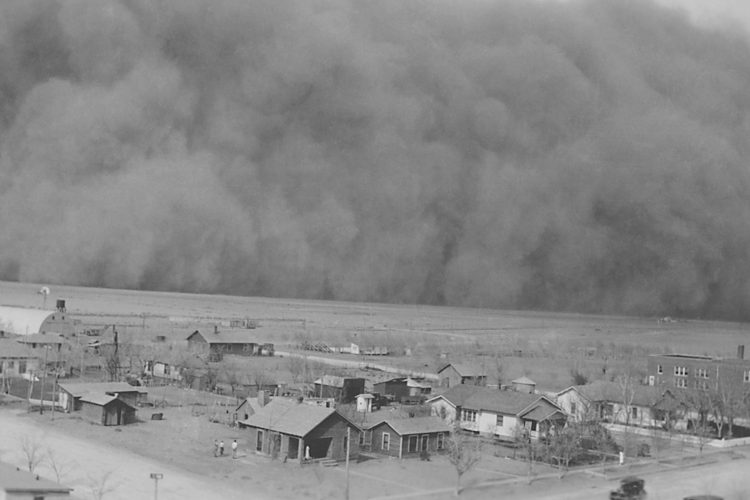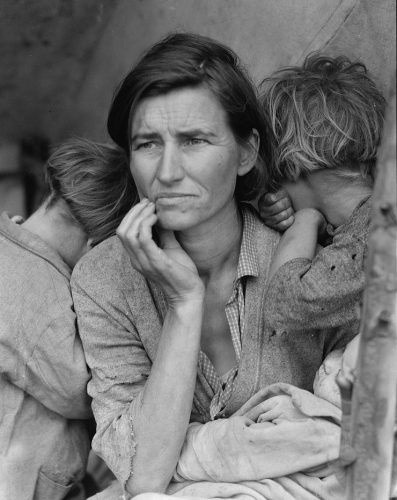The Great Plains debate: preventing Dust Bowl 2.0
- Like
- Digg
- Del
- Tumblr
- VKontakte
- Buffer
- Love This
- Odnoklassniki
- Meneame
- Blogger
- Amazon
- Yahoo Mail
- Gmail
- AOL
- Newsvine
- HackerNews
- Evernote
- MySpace
- Mail.ru
- Viadeo
- Line
- Comments
- Yummly
- SMS
- Viber
- Telegram
- Subscribe
- Skype
- Facebook Messenger
- Kakao
- LiveJournal
- Yammer
- Edgar
- Fintel
- Mix
- Instapaper
- Copy Link
Posted: 27 June 2023 | Joshua Minchin (New Food) | No comments yet
After a recent trip to Nebraska, Joshua Minchin examines the case for conservation on the Great Plains and highlights why the Dust Bowl still looms large in the memory of many.


The Dust Bowl had devastating consequences for many communtiies, including this one in Kansas
Unless you are intimately familiar with US Government-produced films (and what a specialist subject that would be), you might not have heard of The Plow that Broke the Plains. The 1936 film tells the story of the settlement of the Great Plains (including descriptions of Native American “removal” that most certainly belong in the 1930s) and the riches the soil brought to pioneers marching westwards.
What began as a farming fairytale would end in ecological disaster.
What happened?
The Dust Bowl decimated millions of acres of land across parts of Texas, Oklahoma, Kansas, Colorado and Nebraska, as several years of drought left the topsoil baked and vulnerable to the wind. As the narration in The Plow that Broke the Plains repeats over and over again, the Plains are “a country of high winds, high sun, and of little rain”. What transpired was one of the worst examples of desertification in modern times, crops failed and farmers packed up and moved West – sentenced to life as an “Okie” in California.
The causes of the Dust Bowl are debated to this day (and indeed Plow is a controversial film in some quarters as it lays the blame almost squarely at the door of farmers), but there is a consensus that an abandonment of soil conservation techniques in the drive to grow more during the First World War and the farming of sub-optimal land left the Plains vulnerable to the once in a century meteroelogicla event that followed.
The causal debate is best left to a history publication, not a food and beverage one. No, what’s more interesting to us is the legacy the Dust Bowl has left across the US, both in the short-term Governmental response and the policies implemented today to prevent such a catastrophe ever happening again.
The Franklin D. Roosevelt Presidency brought with it a massive expansion in Government action and intervention when it came to agriculture and conservation – the echoes of which are still felt today.
Agencies were set up to combat the effects of the Dust Bowl, including the Soil Conservation Service (which exists today through the Natural Resources Conservation Service) and the Federal Surplus Commodities Corporation, which redirected food deliberately wasted in a bid to drive up commodity prices to those who needed it most.
Things have changed though…right?
Times have changed, and so have agricultural practices. Farmers are deeply in tune with their land and know the importance of soil conservation – yet the vulnerability to a future Dust Bowl remains.
And so does the legacy of FDR’s intervention. The Federal Government still pays farmers not to farm through the Conservation Reserve Program – for a yearly rental fee, Washington DC will ask those in Nebraska not to utilise parts of your land for produce and instead plant cover crops and other species to “re-establish valuable land cover to help improve water quality, prevent soil erosion, and reduce loss of wildlife habitat”, at least according to the USDA.
But what happens if the price of commodities reaches such a point that the rental fee from Washington DC isn’t enough anymore, what happens if you can get more per acre from wheat than from Capitol Hill? Well, according to Dr David Wedin from the Center for Grassland Studies at the University of Nebraska-Lincoln, that’s exactly what happens.


Probably the most famous photograph of the Dust Bowl era was this one by Dotothea Lange, featuring a desperate mother of seven
Credit: Library of Congress, Prints & Photographs Division, Farm Security Administration/Office of War Information Black-and-White Negatives
Therein lies the Great Plains Debate. Who owns it? Who is responsible for conserving it and making sure we don’t see Dust Bowl 2.0? The Sandhills region of Nebraska is the largest example of grassland left in the world, and the vast majority of it is privately owned. Plenty of that land is used for pasture, rather than crop production, which happens more in Eastern Nebraska closer to the corn belt of Illinois and Iowa.
It doesn’t make sense to farm on the Sandhills – as Dr Nic McMillan (from the Center for Grassland Studies at the University of Nebraska-Lincoln) pointed out, if you till the soil there it will simply blow away before you can do anything with it. Instead, cattle keep the grass fertile and protect the habitat.
But if we again look to history, and to that period just before the Dust Bowl, plenty of sub-optimal land was put into production to combat low prices and an increased need for food. This, in part, contributed to the disaster that followed. The Conservation Reserve Program is a barrier against this in part – not only are farmers paid to not farm, but the lower amount of land in production keeps commodity prices stable.
But the concern for some is the fact that there is still some vulnerability while the Sandhills remain in private ownership. Compared to other states where a much higher proportion of land is in public hands, the Federal Government has little control over what happens on this precious piece of Planet Earth.
Some like it that way – ‘what do politicians on Capitol Hill know about life on the Plains’ is the rhetoric often quoted in response. For now, the arrangement is working and those that ranch on the Sandhills are surely best-placed to look after their own land. The concern comes when food prices rise (or demand increases yet further) and the idea of ploughing that land might become attractive for some.
Arguing for more federal control is a difficult task in many corners of the US, Nebraska included. The current system of conservation relies on the five-yearly Farm Bill, voted on by Congress. It provides the budget for all the above policies which protect the US’ soil and precious natural resources. It is, of course, subject to the same political tensions as any other bill (though there is more bi-partisan cooperation for the Farm Bill than other laws). It is fragile, and it can change. If the money doesn’t get to those farmers, will they look at the land to provide for them? Could you blame them?
It’s a controversial topic, as is any which involves landownership and is linked to great human loss. The idea of the Federal Government purchasing vast swathes of the Sandhills is unlikely to say the least. So we go on in this system that works fine while things are going well, but might not offer adequate protection when times get tough.
Related organisations
Center for Grassland Studies, University of Nebraska-Lincoln




